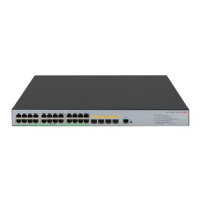279
• Determine the source IPv6 address of MLD multicast-address-specific queries.
Enabling MLD snooping querier
In an IPv6 multicast network that runs MLD, a multicast router or Layer 3 multicast switch sends MLD
queries, so that all Layer 3 multicast devices can establish and maintain multicast forwarding entries, in
order to forward multicast traffic correctly at the network layer. This router or Layer 3 switch is called the
"MLD querier." For more information about MLD querier, see "Configuring MLD (available only on the
S5
500-EI)."
However, a Layer 2 multicast switch does not support MLD. Therefore, it cannot send MLD general
queries by default. When you enable MLD snooping querier on a Layer 2 switch in a VLAN where
multicast traffic is switched only at Layer 2 and no Layer 3 multicast devices are present, the Layer 2
switch sends MLD queries, so that multicast forwarding entries can be created and maintained at the
data link layer.
IMPORTANT:
It is meaningless to configure an MLD snooping querier in an IPv6 multicast network that runs MLD.
lthou
h an MLD snoopin
querier does not participate in MLD querier elections, it mi
ht affect MLD
querier elections because it sends MLD general queries with a low source IPv6 address.
To enable the MLD snooping querier:
Ste
Command
Remarks
1. Enter system view.
system-view N/A
2. Enter VLAN view.
vlan vlan-id N/A
3. Enable the MLD snooping
querier.
mld-snooping querier Disabled by default
Configuring parameters for MLD queries and responses
CAUTION:
In the configuration, make sure that the interval for sending MLD general queries is greater than the
maximum response delay for MLD general queries. Otherwise, IPv6 multicast members might be deleted
by mistake.
You can modify the MLD general query interval based on the actual condition of the network.
A multicast listening host starts a timer for each IPv6 multicast group that it has joined when it receives an
MLD query (general query or multicast-address-specific query). This timer is initialized to a random value
in the range of 0 to the maximum response delay advertised in the MLD query message. When the timer
value decreases to 0, the host sends an MLD report to the IPv6 multicast group.
To speed up the response of hosts to MLD queries and avoid simultaneous timer expirations causing MLD
report traffic bursts, you must properly set the maximum response delay.

